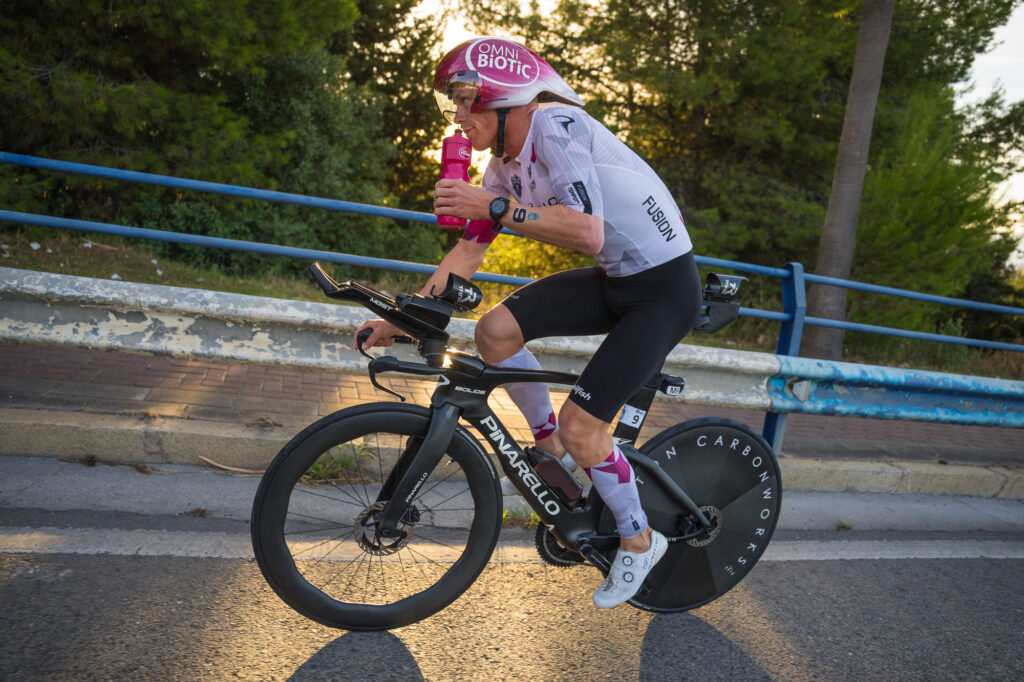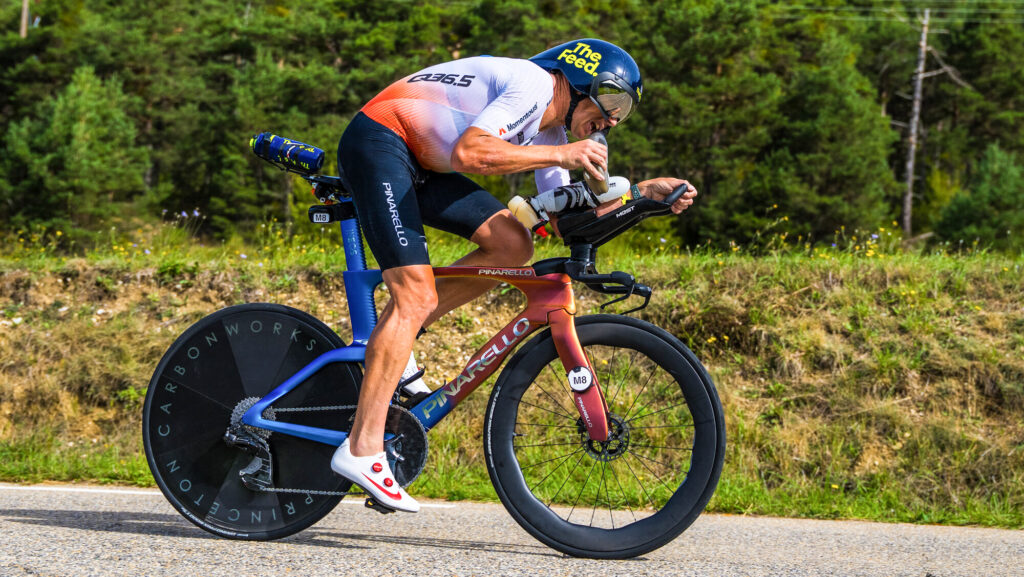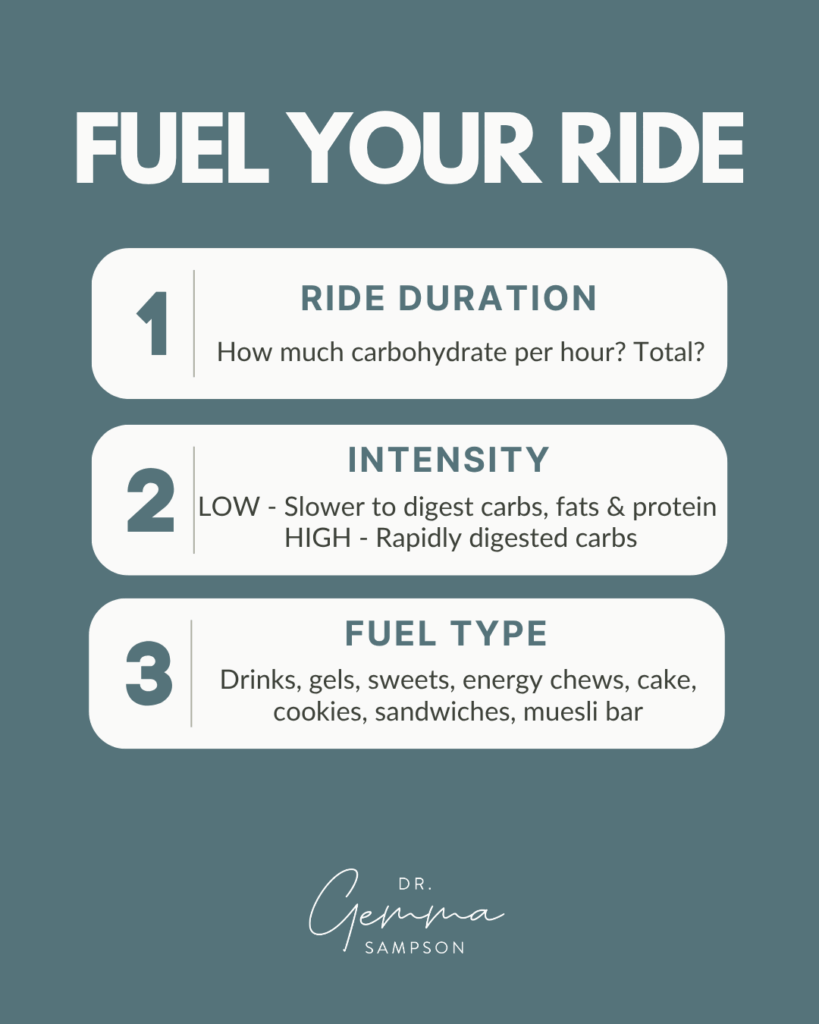Why Pros Do High Carb Better (And How You Can Too)

Casper Stornes fuels on the bike at the IRONMAN 70.3 World Championship in Marbella. Photo: Kevin Mackinnon
Before the 70.3 world championships, Casper Stornes told Slowtwtich he was aiming to take in 180 to 200 g of carbohydrate per hour on the bike. Jelle Geens wanted to hit 120 g, Kristian Blummenfelt 160 g, and Gustav Iden was shooting for 130 g. Just like watts on the bike, or weekly training hours, the pros can throw out big numbers. While we all might be a little guilty of trying to copy what the pros do – when it comes to nutrition, attempting to hit their high carbohydrate targets can easily lead to gut distress and, albeit hilarious, embarrassing bathroom horror stories.
Still, it’s become clear to everyone that if you aren’t eating enough carbs, you aren’t going to perform your best. So, what can we learn from the high carb numbers the pros talk about? Talking to advanced sports dietitian Dr. Gemma Sampson, who specializes in performance nutrition for endurance athletes, it’s all about understanding the context of those high carbohydrate numbers.
Why Intensity Really Matters For Fueling Exercise
Dr. Sampson notes that, first, we must remember there are two sources of fuel: carbohydrates and fats. Then, it’s about how much fuel we can absorb and consume during exercise. Crucially, what brings those two things together is intensity.
“Our exercise intensity will primarily drive how much energy we are using as fuel and what rate –essentially how many grams we are using per minute or per hour,” Dr. Sampson explains. “The higher the intensity – the more watts we push, the more power we generate, the faster we swim, run or bike – the more carbohydrates we are burning.”
The intensity factor is why fueling can look a bit different in the pro ranks.
“The fitter that we become, the more we are able to improve our ability to use fat as fuel at lower intensities, but we are still always using significantly more carbs the more power we generate,” she says.
Dr. Sampson points to a recent study that looks at carbohydrate use in both professional and amateur cyclists. Athletes performed a VO2 max test, and their data was collected including power output, gas exchange and lactate to determine which fuel source, fat or carbohydrate, their body was using throughout the test.
“In a cycling context, typically when athletes are expending between 80 to 100% of their VO2 max, they can be burning between 4 to 6 g of carbs per minute,” she says. “I’ve seen hundreds of athletes’ data and observed a similar pattern that, when racing around what people define as FTP, they are burning around 800 to 900 kcal per hour, almost exclusively from carbohydrate.”
“If we look at the data from this metabolic flexibility study, when an amateur is riding 300 watts, they are relying 100% on carbohydrates as fuel, burning around 6.4g of carbs per minute – that’s 386g carbs per hour!” she continues. “The same 300 watts can feel much easier for a pro. They’re still burning 254 g of carbs per hour (4.2 g/min), but they are also still getting a small amount of energy from fats, about 25 g per hour (0.42 g/min) because the intensity is easier for them. But if a pro was racing at 400 watts, they’d be burning the same 382 g carbs per hour (6.4 g/min) that the amateur was.”
In layman’s terms, if you were riding with Cam Wurf, no doubt you’d be working harder and therefore burning more carbs then he would be at the same power output. However, if you were riding at the same intensity, theoretically, you’d be burning the same amount of fuel.

Cameron Wurf takes in carbs during the IRONMAN World Championship in Nice. Photo: Kevin Mackinnon
Absorption Matters and Why 200 g Per Hour Isn’t “Normal”
All this sounds good in theory, but in the real world, we all know fuel hits everybody differently. Even among the top pros listed at the beginning of this article, their fueling varied and that’s for good reason.
“Just because our body is using an amount of carbohydrates as fuel doesn’t mean we can tolerate or absorb the same amount,” Dr. Sampson points out. “Once people are consuming >120g of carbs per hour, there is a much higher risk of experiencing gut issues such as diarrhoea, vomiting or bloating, whether you’re a professional or not. So, these pro athletes who are consuming 200 g of carbs per hour, they are not ‘normal’ which is why they excel at their sport.”
So what are normal people supposed to do? Unless you go into a lab and get tested, figuring out what you can tolerate comes down to good old fashioned trial and error.
“In race situations where performing at your peak is the priority, I recommend you fuel at the highest capacity that you, as an individual, can tolerate,” Dr. Sampson says. “We are almost always burning more than we can physically digest and, on an individual level, these amounts can vary for many reasons. The extreme ends of the spectrum may be possible, but they definitely are not common. I’ve had athletes who cannot absorb more than 55 g carbs per hour, as well as those who are taking over 140 g of carbs per hour for events eight hours long. But the more you are able to fuel during racing means the less likely you are to rely on glycogen stores, saving more for the final sprint at the finish line.”
Figuring Out How Many Carbs You Need and Can Tolerate
Dr. Sampson has been working with professional and amateur cyclists and triathletes for well over a decade (and she even has an IRONMAN finish to her name), helping them all master their optimal fueling. To figure out how many carbohydrates you need in training and racing and, more importantly, how much you can tolerate, she recommends a three-step approach.
“The way I like to teach people about fueling is to take it in three steps: first, duration; second, intensity of the training session; and, third, adapting the type of fuel to the purpose of the training session,” she says. “We don’t always need to be fueling the highest amount possible in training, but doing so in racing will definitely help you perform better.”

So you might have an easy 3 hour base ride, but even if the intensity is low, the duration is long so you will need more fuel overall. You might need the same amount of fuel for a 90 minute ride that is high intensity. Interestingly, Dr. Sampson suggests considering the type of fuel too. The higher the intensity, the faster absorbing liquid fuels might be better, but on a long easy base ride, a granola bar might be a good choice.
A qualified nutritionist can streamline the trial and error process but, as a general place to start, Dr. Sampson suggests 50 to 60 g per hour for low intensity, 60 to 70 g for moderate intensity, 70 to 90 g for high intensity, and >90 g for race intensity.

“Anything less than 50 g of carbs per hour I would classify as low intensity training, which is really only useful in recovery training,” she puts simply. “As the intensity increases and the need for performance increases, so should the amount of carbs you are using.”
“In a racing context, I would typically be recommending between 90 to 120 g (of carbs), and rarely would go over that unless it has been thoroughly tested in training to avoid any mishaps in the porta-potties,” Dr. Sampson continues.
Just like your running paces or power zones on the bike, once you figure out your “nutrition zones,” you can fuel your training and racing with more ease and consistency, less chance of gut distress, and increase your chance of peak performance – just like the pros.




Start the discussion at forum.slowtwitch.com